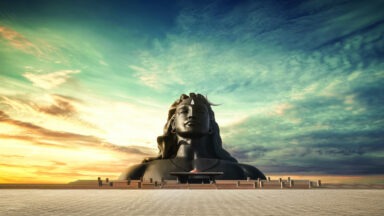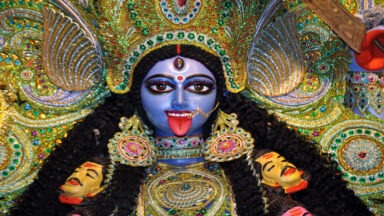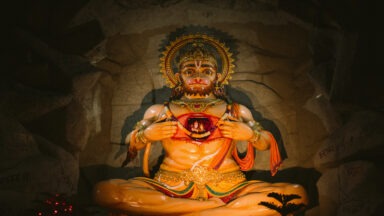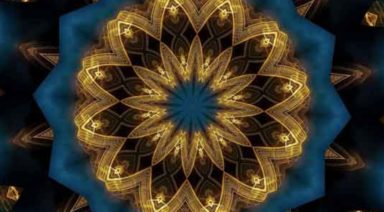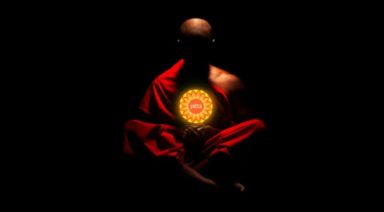Awakening to Saraswati: How the Goddess Shows Up in Your Life

One of my first encounters with Saraswati, the Hindu Goddess of speech, arts, and music, was the day my teacher spontaneously walked in to observe my teaching. Despite the fact that I had been teaching for years, the moment he entered the room, I lost my composure. Who was I to teach? What did I know? What if I said something wrong? My skin turned fire-engine red, and itchy hives covered my throat. I even nearly lost my voice!
I could hear an inner urge to get up and fight—to courageously teach the class. And somehow, I made it through. Yet that night, I faced my inner saboteur—the coward that held me captive to my doubt, fear, and unworthiness. Turns out, it was the shadow aspect of Saraswati.
Have you ever lacked confidence in yourself, even though you are proficient at what you do? Have you ever turned your power over to another out of fear of being wrong? Have you ever lost your voice or felt as if what you had to say wasn’t heard? This inability to express our creative power is the shadow aspect of Saraswati, a goddess who shows us this shadow side when we fall prey to judgment, criticism, doubt, and fear.
The good news is that through yoga and meditation, we can remember our abilities and find the confidence to speak about what we know and can share more fully with others as a result. With daily meditation, we can overcome tremendous feelings of inadequacy and tap more readily into our inherent gifts and talents.
As my practice deepened, my confidence has soared—and I can tell you firsthand what joyous freedom I’ve experienced as I’ve become better able to express myself. Understanding both the light and shadow sides of the goddess Saraswati has helped me do this.
Who is Saraswati?
This goddess was married to her consort, Brahma, albeit briefly due to her independent nature. Her commitment to meditation and her devotion to the music and arts takes her away from Brahma too many times. In fact, one day, she arrives late to an important ceremony where Brama is being honored, and this time he won’t forgive her and demands a divorce. She isn’t bothered, as she won’t be tied down or forced to be a subservient wife.
Her life is dedicated to accessing deep states of meditation and discerning truth from within. In depictions of Saraswati, her swan, the Hamsa, sips on water and milk and is able to separate milk from water, which metaphorically speaks to knowing our truth. She teaches us to go within and trust in our inherent gifts. This is why it makes sense that her shadow side would have us doubting those gifts and questioning our intuitive powers.
We find Saraswati in rivers, oceans, streams, and lakes—anywhere there is water. In fact, her name means “to flow”—to be in the flow with your creative capacities. She connects us to our artistic gifts; when you see a beautiful dancer, read a wonderful piece of writing, or hear someone speak from the heart and cut right to the beautiful truth. That is Saraswati at work.
When I think of her in great artists, I think of songwriters like John Lennon, great speakers like Martin Luther King Jr., and the work of Vincent Van Gogh and Cezanne. Even better, she is the aspect of consciousness within each of us that holds creative ideas and sparks innovation, and she has everything to do with communication. We could even say that cell phones and social media are aspects of Saraswati’s creative energy in humans to innovate.
Here are some ways you can work with Saraswati in your life:
Daily rituals and practices help us reconnect to our creativity, release doubts and fears, and step more courageously into contributing to life.
Here are a few practices I do daily when I want to call on Saraswati’s energy:
- Spend a day dedicated to watching your speech and being curious about where any negativity that bubbles up from.
- Meander on the way home after work rather than taking your usual, straightforward route, and let your path unfold without an agenda to spark your creativity.
- Download a language program onto your phone and practice a new language—just for the fun of it.
- Pick up a musical instrument.
- Play around on your computer and be in awe of all that it can do.
- Write a letter, poem, or a song, and share it with someone.
- Chant or sing, as this opens up the throat chakra and allows for free form expression.
Asana Practice
Backbends, such as shalabhasana (locust) supta virasana (reclined hero’s pose), and ustrasana (camel pose), are potent physical practices that enhance shoulder and throat opening. By practicing these backbends, we activate the throat chakra, which helps energy move through our bodies, allowing for more flow and freedom of expression. Practice these backbends for 40 days and notice how the way you express yourself changes.
Inner practices
- Sit quietly for 5 minutes and simply watch your breath, then ask a question you need clarity around. When the 5 minutes are up, write whatever comes to mind in your journal. This exercise always helps me to tap into my innermost self, which almost always leads to helping me find more clarity about whatever is “up” for me.
- Light a candle, place a picture or statue of Saraswati in front of you, and chant the following mantra using a mala 108 times: Om AIM hreem shreem Saraswati namaha. Chanting helps open us up to the inner domains of consciousness, where our active mind quiets, and we can feel the potency of Saraswati as sound vibration that heals and liberates our ability to express ourselves creatively.
- Begin a mantra meditation practice. Mantras are sound therapy, so when we use mantras, we are tapping into Saraswati’s most subtle form, sound. Sound vibration heals from the inside out, so it can help us feel happier and better able to enjoy our lives.
Ridding Your Negative Personal Narratives With Lord Shiva
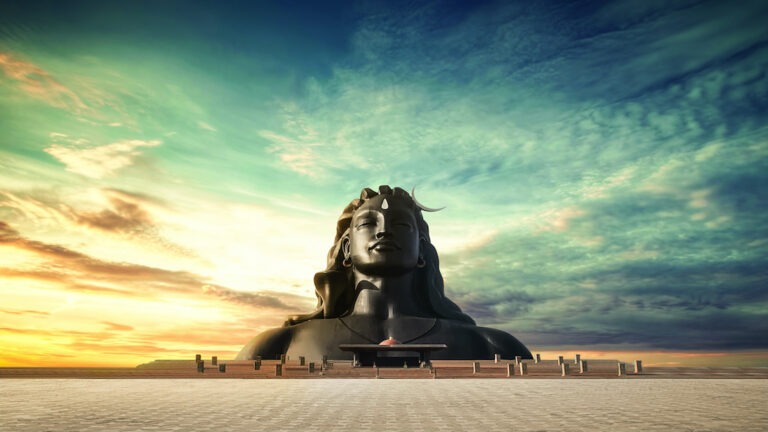
Lord Shiva is a well-known and worshipped Hindu deity. He is one of the Holy Trinity (the Trimurti), which consists of Lord Brahma, Lord Vishnu, and Lord Shiva. What each represents in our familiar terms are brand new beginnings (Brahma), the middle of everything in existence (Vishnu), and the endings (Shiva). When Shiva, as the Lord of Dissolution, gives us the endings, he also provides the space for Brahma to instill a bright new beginning. It is from the void of nothingness, or space, left after something comes to an end, that Brahma responds by bringing the start of something new.
Shiva, Lord of Dissolution
Shiva, The Auspicious One, is also known as Mahadeva or The Great God. He is worshipped as the Supreme Being in Shaivism, a major institution within Hinduism. I like to explain the concept of endings giving way to brighter new beginnings with the metaphor of a bookshelf filled with storybooks that represent our own considerations about ourselves.
Imagine you have a large bookshelf in your mind. The bookshelf is jam-packed with books whose titles represent your own self-judgments or concepts of yourself. One thing to mention is that we are constantly in judgment of ourselves. We are usually in judgment of something and judgments can be good or bad. For instance, we might see a book entitled ‘I am a great Mother,’ or ‘I am a giving person.’
Conversely, we have the debilitating narratives. ‘I am unworthy’ or ‘I am not flexible enough’ as some of the titles we’re experiencing. But the debilitating narratives are simply opportunities to grow or bring Shiva into our lives.
Shiva comes along as the Lord of Dissolution; he shows us where we are hindering our growth with certain stories or ways of being. For instance, when you decide you are fed up with thinking of yourself as unworthy, or not good enough, Shiva gives you the willpower to dissolve that story. The ‘I am unworthy’ book gets removed from the shelf and thrown to the wayside.
What is left behind is an open space, an open space ready and willing to house a new book with a new title. Brahma steps in and gives us the capacity to formulate a new storybook title that feels brighter and shinier as a new beginning, or judgment of self. For example, we switch from the ‘I am unworthy’ mantra to ‘I am good enough.’ In this way, Shiva and Brahma give us the ability to challenge our belief system and change it for self-betterment.
Shiva, Lord of Dance
A common depiction of Shiva is one of a dancing four-armed deity. In this form, Shiva is known as Nataraja, or the Lord of Dance. He is seen dancing in a halo of fire which represents samsara, or ‘flowing around.’ In his upper right hand, Shiva holds a hand drum said to have drummed the first drum beats to help create everything, paired with the sound of “Om.”
His upper left hand holds a flame said to have the ability to destroy on behalf of transformative new beginnings. His bottom lower right hand holds abhayamudra, a gesture used to convey fearlessness. His bottom left hand mimics the lifted position of his left leg. This symbolizes a respite soul’s find from the earthly troubles on a path towards soul liberation. His lifted left leg is a journey towards this elevated consciousness. Finally, the snake he wears around his waist is the creative energy that exists in our psychic body.



